| The natural distribution of Norway Spruce |
I have chosen this tree, as it is yet another favourite of mine - I expect that I shall be writing this on almost every tree profile that I write! I think that it looks especially good as a young tree, it has a lovely full and well proportioned profile with such rich, healthy looking green needles.
Norway Spruce has a natural distribution through the more mountainous areas of central Europe and a more general distribution across Eastern Europe and Scandinavia. Pollen evidence shows that it was present in the British Isles before the last Ice Age but failed to naturally re-establish itself after the ice retreated. It is thought to have been introduced into Great Britain before the 15th centuary.
It has for many centuries been planted beyond it's natural range, both as a timber and shelterbelt tree and in countless millions as the classic Christmas tree. It is a tough and vigorous tree that is not prone to serious attacks from pests and diseases. It's dense natural habit provides year round shelter for many birds and mammals. The seeds are eaten by birds such as the goldcrest and long tailed tit and also red squirrels.
Soils
This is quite an adaptable tree that can grow well on both clay soils and sandy ones. It prefers a deep loam soil (as do most plants!) in an area with rainfall of at least 510mm (20") but preferably 900mm (35+") per year. They prefer an acid soil with a ph between 5 and 7.5 but will grow with reduced vigour and density on soils with a ph level higher than this.
Growth
Larger trees such as those bought as bare rooted Christmas trees have a low survival rate. If they live, the new growth will be very short often only a few cm's and often quite yellowish in colour. However within a year or two they will regain full health and vigour and can grow into fine trees.
Plantation grown trees need to be thinned on a regular basis, otherwise they will grow very tall and thin making them highly susceptable to windsnap as happened here in the "Tempete" of December 1999 when winds gusted to 150km/hour. Almost every Norway Spruce plantation in this locality was devastated, with most trees snapped clean off between 2 and 4 meters above ground due to their slender, whippy stems that are the result not being thinned sufficiently during the development of the plantation.
Frost
Although the mature trees are immensely hardy and can survive extreme mountain conditions the new Spring shoots are very frost tender and a late frost can cause a lot of cosmetic damage to Christmas tree plantations. For this reason, trees for this purpose are grown from seed collected from parts of Europe where the trees flush late, either from areas of Germany or Romania. The damaged trees usually recover from frost damage, although growth for that year will usually be reduced.
Fruiting
Norway Spruce has a natural distribution through the more mountainous areas of central Europe and a more general distribution across Eastern Europe and Scandinavia. Pollen evidence shows that it was present in the British Isles before the last Ice Age but failed to naturally re-establish itself after the ice retreated. It is thought to have been introduced into Great Britain before the 15th centuary.
It has for many centuries been planted beyond it's natural range, both as a timber and shelterbelt tree and in countless millions as the classic Christmas tree. It is a tough and vigorous tree that is not prone to serious attacks from pests and diseases. It's dense natural habit provides year round shelter for many birds and mammals. The seeds are eaten by birds such as the goldcrest and long tailed tit and also red squirrels.
Soils
This is quite an adaptable tree that can grow well on both clay soils and sandy ones. It prefers a deep loam soil (as do most plants!) in an area with rainfall of at least 510mm (20") but preferably 900mm (35+") per year. They prefer an acid soil with a ph between 5 and 7.5 but will grow with reduced vigour and density on soils with a ph level higher than this.
Growth
As is normal during the first year following planting the growth rate is not spectacular as the plant in concentrating on developing its root system for future growth, so perhaps 12-20 cm is realistic, perhaps a little more if your weed control is excellent and in a year with plenty of warm summer rain. The survival and growth rate is higher if your plants are stocky and have been well handled by the nursery that you purchased them from. Growth soon increases to be 60-90cm per year, even up to 180cm in perfect conditions. Height growth however, decreases rapidly after about 60 years.
Larger trees such as those bought as bare rooted Christmas trees have a low survival rate. If they live, the new growth will be very short often only a few cm's and often quite yellowish in colour. However within a year or two they will regain full health and vigour and can grow into fine trees.
Plantation grown trees need to be thinned on a regular basis, otherwise they will grow very tall and thin making them highly susceptable to windsnap as happened here in the "Tempete" of December 1999 when winds gusted to 150km/hour. Almost every Norway Spruce plantation in this locality was devastated, with most trees snapped clean off between 2 and 4 meters above ground due to their slender, whippy stems that are the result not being thinned sufficiently during the development of the plantation.
Frost
Although the mature trees are immensely hardy and can survive extreme mountain conditions the new Spring shoots are very frost tender and a late frost can cause a lot of cosmetic damage to Christmas tree plantations. For this reason, trees for this purpose are grown from seed collected from parts of Europe where the trees flush late, either from areas of Germany or Romania. The damaged trees usually recover from frost damage, although growth for that year will usually be reduced.
Fruiting
The beautiful flowers appear in the late Spring on the tips of the branches once the tree is about 30 - 35 years old. After pollination by windblown pollen grains, the cone begins to develop, taking from 5-7 months to reach maturity and as it grows larger begins to hang downwards from the branch.
The cones are generally between 9 and 17cm long with the longest cones being found on trees that originate from the more Southeastern parts of Europe.
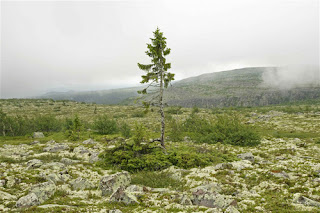 |
| Old Tjikko 9550 years old, discovered by geologist Leif Kullman |
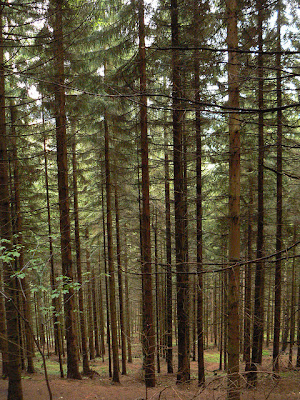 |
| A typical, dense forest of Norway Spruce trees located close to Jachymov, Karlovarsky to the N.W. of Praha (Prague) in the Czech Republic. Permission to use this photo has been kindly granted by abejorro34 and appears in his Flickr photo albums http://www.flickr.com/photos/abejorro34/with/4896848449/ |
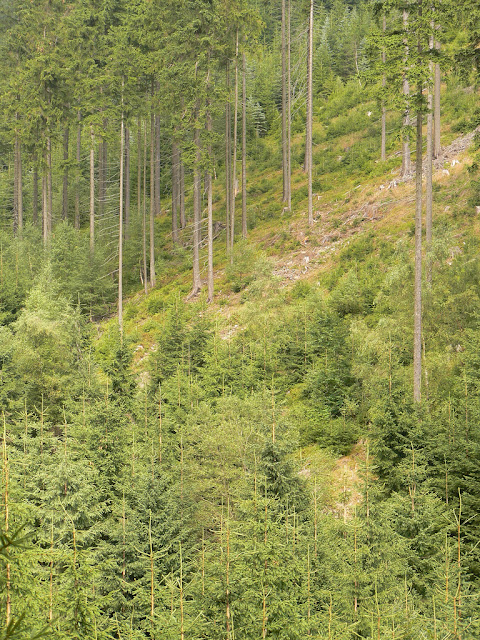 |
| Prolific Norway Spruce regeneration adjacent to a light canopy of mother trees. These provide the seeds for natural regeneration without having to replant. The trees are growing in the mountains near Jachymov, Karlovarsky to the N.W. of Praha (Prague) in the Czech Republic. Permission to use this photo has been kindly granted by abejorro34 and appears in his Flickr photo albums http://www.flickr.com/photos/abejorro34/with/4896848449/ |
Timber
A well managed plantation will produce quality wood of great versitility that is easy to work, cuts cleanly and that can be sanded to a fine surface. It also glues well and a good looking finish results from painting and varnishing. It is used in large quantities for interior building construction, joinery, flooring and wall panelling, boxes, plywood, chipboard and paper pulp. Older traditional uses include firewood (as is still common in Eastern and Northern Europe), charcoal, scaffolding poles, ladders, boat masts and oars, High quality slow grown wood has excellent tonal qualities and is used for piano soundboards and violin and guitar bellies. The resin was gathered to make healing ointments, plasters and skin pastes. BEER!!
The young shoots, picked when growing in Spring can even be used to brew spruce beer which has been described as ranging in taste from floral, citrusy and fruity to cola like and the rather less surpising, resinous and piney, It has been quite widely brewed in Northern Europe, the U.S. and Eastern Canada. A slightly less exciting, non alcoholic soft drink version can also be made. More information and a spruce beer recipe from 1796 can be found here- http://en.wikipedia.org/wiki/Spruce_beer
Norway Spruce as a hedge.
Here is a somewhat curiously shaped Norway Spruce trunk that I spotted in Flickr whilst looking for photos for this post. This looks like it has grown from a number of trees that have been planted very close together. I'm presuming that it has been planted and has not arisen by means of natural regeneration, perhaps a bundle of young trees were left over when the wood was originally planted. The surviving stronger specimens from the bundle have grown and become interwoven with their young trunks fusing together, as is quite common with rubbing branches in a number of tree species.
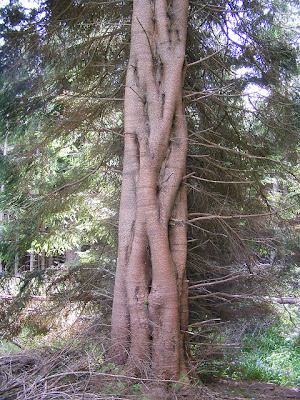 |
| The Candy Twist Norway Spruce. Permission to use this photo was kindly given by Will Anderson and can be seen in his Flickr album. |
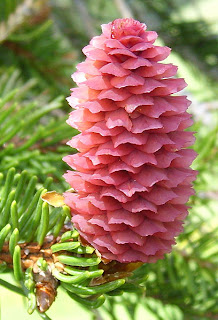

Reserve de France ® Hardwood flooring receive the upmost attention to detail throughout every step of their creation. We have direct relationships with National forests in France , and giving us access to the highest grade French oak lumber and allowing us to hand select each log that your floor is crafted from. From there, each board of your new floor is hand crafted to a high standard in Reserve de France. Every individual log we use can be traced back to responsibly harvested and verified sources from French sustainable forests. In these certified forests, selective cutting is the manner to harvest logs without destroying the forest. Reserve de France - Producer of Solid and Engineered French Oak Hardwood Flooring ready to lay. The logs are "live sawn" in a horizontal manner only. After cutting, the boards are naturally air dried for 12 to 24 months. Before production into wide planks for flooring, the planks are slowly kiln dried for 30 days for added stability and to bring the moisture content to indoor levels. At this production time, we also use the high tannin content of the French Oak to accelerate the aging process to give different natural colors to the flooring plank without using any artificial coloring or stain. You can get here the best quality of hardwood flooring, french oak, french oak flooring, engineered flooring, engineered french oak flooring, french oak factory, french oak manufacturer, hardwood flooring miami, hardwood flooring nyc and hardwood flooring Chicago.
ReplyDeleteThanks for sharing useful blog. you may find online Spruce-logs here Spruce-logs for sale online
ReplyDelete